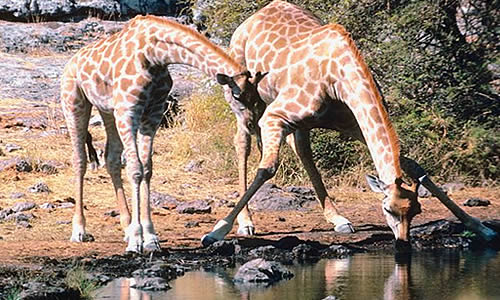PHYLUM:Chordata
CLASS:Mammalia
ORDER:Artiodactyla
FAMILY:Giraffidae
GENUS:Giraffa (one who walk swiftly) Camelopardalis (camel marked like a leopard)
COMMON NAME: Giraffe
SCIENTIFIC NAME: Giraffa camelopardalis
TYPE: Mammals
DIET: Herbivore (selective browsers that prefer new growth foliage of acacia, mimosa brush, and Combretum trees 2 to 5 m high)
AVERAGE LIFE SPAN IN THE WILD: 25 years
SIZE: 14 to 19 feet
WEIGHT: 1,750 to 2,800 pounds
SIZE RELATIVE TO A 6-FT MAN:

GIRAFFE HABITAT
Giraffes can inhabit savannas, grasslands or open woodlands. Giraffes prefer areas enriched with acacia growth (a genus of shrubs and trees). Most giraffes live either in East Africa or in Angola and Zambia in southwestern Africa. Until the middle of the 20th century giraffes were also commonly found in West Africa, south of the Sahara. But populations there have fallen sharply and become increasingly fragmented.
GIRAFFE BEHAVIOUR
Female giraffes associate in groups of a dozen or so members, occasionally including a few younger males. Male giraffes tend to live in bachelor herds, with older males often leading solitary lives. A individual giraffe can join or leave the herd at any time and for no particular reason.

HOW DOES A GIRAFFE MOVE?
Giraffes have two ways of moving, a loping walk and a gallop. When they walk, the giraffes move both feet on one side of their body in unison, followed by both feet on the other side. When they run, giraffes move the front feet together, then the back feet, swinging the hind feet up and planting them in front of the forefeet. While running, the neck of a giraffe moves backward and forward to keep the animal balanced. Giraffes have a top speed of about 56 kilometres per hour (35 miles per hour), however, because its legs are so long a galloping giraffe does not appear to be going very fast.
Giraffes are not great travelers, despite their long legs. Giraffes cannot walk over swampy ground because their hooves quickly sink and they very rarely wade across rivers. Giraffes on opposite banks of a river may never come into contact, unless the water levels drop.
HOW DOES A GIRAFFE BEND DOWN?
For giraffes, bending down is a daily challenge. To reach ground level for example, when drinking a giraffe has to splay its front legs at an angle of almost 45 degrees. A giraffes circulatory system is also specially modified, because the high pressure needed to pump blood up to its head could cause brain damage when the head is lowered. To deal with this problem, giraffes have elastic blood vessels that relieve some of the excess pressure.

QUETION
1.How does giraffe bend down?
2 How does male giraffe give birth?
3.How long does giraffe?
4.Where is the habitat of giraffe?
5.What is the diet of giraffe?
https://drive.google.com/open?id=1L1VJ-iuZvQbp7oZApx8RTmPeA6mf84jK

Komentar
Posting Komentar